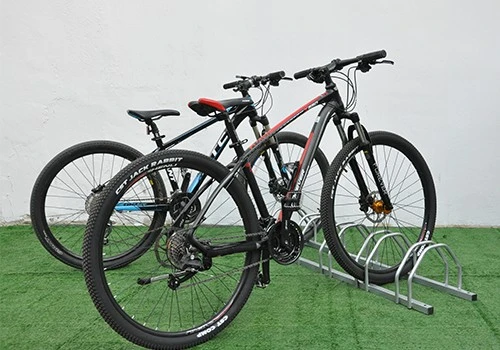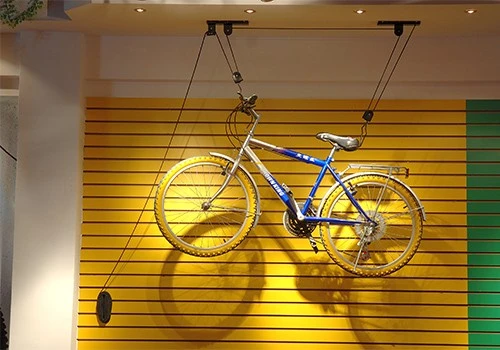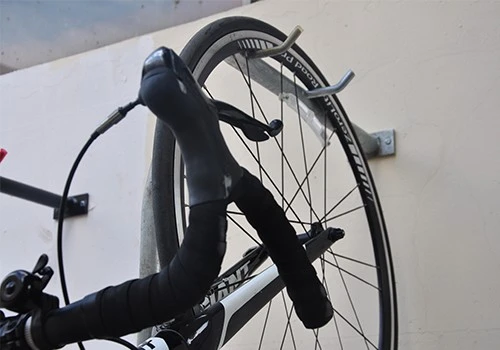Specifications
Model Number : PV-SC-001
Type: Bike parking and storage
Color:Yellow,Black,Green,Red,or Customized.
Style : both indoors and outside
Material : carbon steel
Loading: According to customer need
Size :195*23.2*75cm,200.55*23.2*75cm,or Customized.
Finish: hot-galvanized
Specifications
Model Number : PV-0081-01
Type: Bike parking and storage
Color:silver
Style : both indoors and outside
Material : carbon steel
Loading: According to customer need
Size :Height 1463mm, Depth 1114mm
Finish: hot-galvanized
Model Number : PV-0081-01
Type: Bike parking and storage
Color:Black
Style : both indoors and outside
Material : carbon steel
Loading: 2-10 bikes (According to customer need)
Size :Height 1463mm, Depth 1114mm
Finish: hot-galvanized
Model No.: PV-H1
Size: w605*D400*H330mm
Specification: Round tube:¢16*1.2mm
Finish: Power coated
Net Weight: 1.6 kgs
Packing size:6pcs/ctn
MOQ: 100pcs
Model Number : PV-0024-01
Material : carbon steel/stainless steel
Loading: according customer space size,we can design according the size
Size : W1977*D1130(depend on your parking space)*H2500mm
Finish: Powder coated ,hot-galvanized/electric polish
Packing size :2000*2000*2500mm(40 parking space )
Powder coated ,hot-galvanized/electric polish
Product number:PV-0046-01
Material:carbon steel
Specification:10.2*59*28CM or Customized.
MOQ:100PCS
Port:Shanghai
Trademark:PV
Model Number : PV-0081-01
Type: Outdoor Bike Parking Rack
Style : both indoors and outside
Material : carbon steel
Loading: 2-10 bikes (According to customer need)
Size :170.5*116*148CM
Finish: hot-galvanized
Model Number : PV-0055-01
Type: compact flat pack /slot
Color:black / silver /yellow/optional
Style :Outdoor/indoor
Material : carbon steel/ stainless steel
Capacity : park 6 bikes
Size : L1400*W1054*H840mm
Net weight :38KG
Finish: powder coating / hot galvanized /elctropolishing
Packing size :1490*860*160mm 1pcs/ctn
Product Name: Multi-Capacity Horizontal Two Tier Bike Parking Rack
Material: Carbon Steel
Finish: Powder coated
Post: 80mm * 80mm thickness: 3mm
Steel plate: thickness: 2mm
Dimension: 1325*1890*1830mm
Weight: 370 kg/set
Model: PV-0067-01
Material: stainless steel 304
Pipe: 50 mm* 2.5 mm
Size: 900*700 mm(L*W)
Surface treatment: polishing

For many homeowners and cycling enthusiasts, a bicycle is more than just a mode of transportation—it’s a hobby, a fitness tool, and even a cherished possession. But as any bike owner knows, keeping bicycles organized at home can be a challenge. A cluttered garage with bikes leaning against walls, tripping hazards in the hallway, or weather-damaged frames left outdoors are common frustrations. That’s where residential bicycle racks come in: they’re the solution to turning chaos into order, protecting your bikes, and maximizing space in your home.
In this guide, we’ll break down everything you need to know about choosing the right residential bicycle rack for your needs. We’ll cover the key benefits of using a dedicated bike rack, the different types available on the market, critical factors to consider when shopping, and finally, introduce our top picks—including our own line of high-quality racks designed to meet every home cyclist’s needs. Whether you have one bike or a whole family’s collection, this guide will help you make an informed decision that keeps your bikes safe, accessible, and out of the way.
Before diving into the types of racks, let’s start with the basics: why invest in a residential bicycle rack in the first place? You might think, “I can just lean my bike against the wall”—but that approach comes with more drawbacks than you might realize. Here are the top reasons a dedicated rack is a smart choice for any home with bikes:
Bicycles are delicate pieces of equipment. Frames can scratch when leaned against rough garage walls or other objects, and wheels can bend if a bike tips over. Outdoor storage (without protection) exposes bikes to rain, snow, UV rays, and rust, shortening their lifespan. A good bike rack holds your bike securely in place, preventing scratches, dents, and weather-related wear. For example, a wall-mounted rack that grips the bike by the tires (rather than the frame) eliminates the risk of frame damage—perfect for high-end road bikes or vintage models you want to preserve.
2. Maximize Space in Your Home
Space is a premium in most homes, especially in apartments, small garages, or houses with limited storage. A bicycle can take up a surprising amount of floor space when left lying flat or leaning. Residential bike racks are designed to optimize space: wall-mounted racks lift bikes off the floor, while freestanding vertical racks stack bikes vertically, allowing you to store multiple bikes in a small footprint. For example, a 5-bike freestanding rack can fit in a corner of your garage, taking up less space than two bikes leaning side by side.
3. Improve Safety and Organization
A cluttered space is a dangerous space. Bikes left on the floor are tripping hazards for kids, pets, and adults—especially in garages or hallways where visibility might be low. A bike rack keeps bikes off the ground and in a designated area, reducing the risk of falls. It also makes your space look neater: no more bikes blocking the garage door or taking over the entryway. Plus, an organized rack means you can find and access your bike quickly when you’re ready to ride—no more moving other bikes out of the way to get to yours.
4. Extend the Life of Your Bikes
By keeping your bikes secure and protected, a bike rack helps them last longer. Rust from rain, scratches from collisions, and bent components from tipping can all lead to costly repairs or the need to replace your bike sooner. A rack that keeps bikes dry (if stored indoors) and stable prevents these issues, so you can enjoy your bikes for years to come. For e-bike owners, this is even more important: e-bike batteries and electrical components are sensitive to moisture and impact, so a secure rack is a must to protect your investment.

Not all bike racks are created equal. The best option for your home depends on factors like the number of bikes you have, the space you’re working with, and your personal preferences (e.g., do you want to drill into walls, or prefer a portable solution?). Below, we’ll break down the most common types of residential bicycle racks, their pros and cons, and ideal use cases.
1. Freestanding Bicycle Racks
Freestanding racks are exactly what they sound like: self-supporting units that don’t require mounting to walls, floors, or ceilings. They’re a popular choice for garages, basements, or even covered patios, and they come in a range of sizes—from small racks that hold 1-2 bikes to large models that can accommodate 5+ bikes.
Most freestanding racks use a combination of base weight and vertical supports to keep bikes stable. Some have hooks or arms that hold the bike by the frame or wheels, while others use a “grid” design where bikes are leaned into slots. Many also include additional features like hooks for helmets, locks, or water bottles.
2. Wall-Mounted Bicycle Racks
Wall-mounted racks attach directly to your garage or basement walls, lifting bikes off the floor to save space. They’re a great choice for small spaces where floor space is limited, and they come in two main styles: horizontal (bikes stored parallel to the wall) and vertical (bikes stored perpendicular to the wall).
Horizontal wall-mounted racks typically use arms or hooks that extend from the wall, holding the bike by the top tube or wheels. Vertical wall-mounted racks (also called “hanging racks”) use hooks that grip the bike by the front wheel or frame, allowing the bike to hang vertically—this style is especially space-saving, as it only takes up a few inches of wall space per bike.
3. Ceiling-Mounted Bicycle Racks
Ceiling-mounted racks are the ultimate space-saving solution: they hang bikes from the ceiling, keeping them completely out of the way. They’re a great choice for garages with high ceilings or anyone who needs to free up both floor and wall space.
Most ceiling racks use ropes, pulleys, or hooks to suspend bikes from the ceiling. Pulley systems allow you to lower the bike down when you need it and lift it up when you’re done—perfect for bikes you don’t use every day. Hook-style ceiling racks are simpler: they’re fixed hooks that you lift the bike onto (usually by the frame or wheels).
Now that you know the main types of racks, how do you choose the right one for your home? Here are the critical factors to keep in mind—from bike type to space constraints—that will help you narrow down your options:
1. Number and Type of Bikes
The first thing to consider is how many bikes you need to store, and what types they are. A rack that works for a single road bike won’t necessarily work for a family of 4 with mountain bikes, kids’ bikes, and an e-bike. Here’s what to look for:
2. Available Space
Take a look at where you plan to install the rack—garage, basement, apartment hallway, etc.—and measure the space carefully. Ask yourself:
3. Installation Ease
Consider how comfortable you are with DIY installation. If you’re a renter or don’t want to drill holes, a freestanding rack is the way to go—most require no tools to set up (just snap together the parts). If you’re okay with drilling, wall-mounted racks are a great option, but make sure you have the right tools (drill, stud finder) and know how to find wall studs. Ceiling racks are the most difficult to install—you may want to hire a professional if you’re not confident in your ability to drill into ceiling joists.
Our tip: All of our wall-mounted racks come with a detailed installation guide, a stud finder, and all the hardware you need—so even if you’re new to DIY, you can set them up in under an hour.
4. Durability and Material
A good bike rack should last for years, so pay attention to the material it’s made from. The most common materials are:
5. Additional Features
Small features can make a big difference in how useful a bike rack is. Look for these extras:
We designed these racks to fix common pain points—durability, ease, and space-saving:
1. Freestanding 5-Bike Rack (Family-Friendly)
2. Wall-Mounted Bike Rack (Small Spaces)
3. Ceiling-Mounted Pulley Rack (Seasonal Riders)
4. Compact Freestanding 1-Bike Rack (Single Cyclists)

The best rack matches your current needs and future plans—if you might add a bike later, pick a freestanding 2-bike rack instead of 1. Our racks are built to last, but always check weight capacity and tire width compatibility first.
Whether you’re a single commuter or a family of cyclists, we have a rack that fits. Keep your bikes safe, organized, and ready to ride—no more clutter, no more damage.